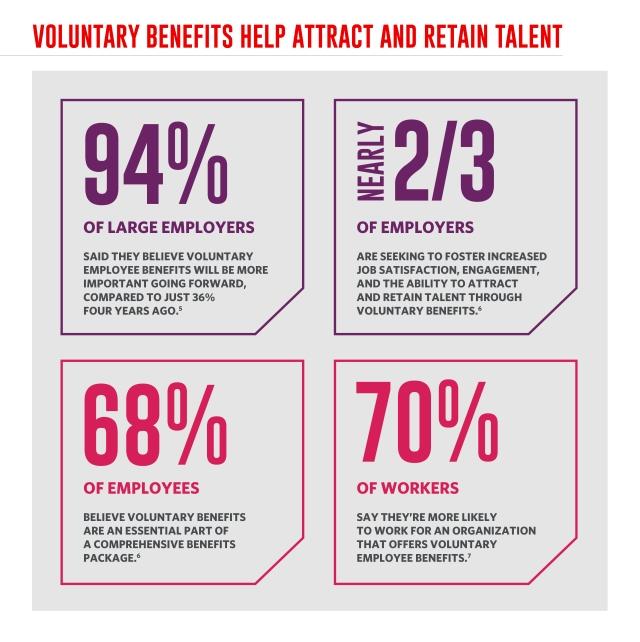Why It Matters:
- Recruiters and Human Resource (HR) professionals are struggling to find workers in a new era of ultra-low unemployment.
- Newly empowered workers are learning they want more than wages from a job, like a full offering of voluntary employee benefits to choose from.
- Employers and HR professionals are increasingly recognizing the value of voluntary benefits when it comes to hiring and retaining talent.
It’s no secret employers want employees. Unemployment in the U.S. fell to 3.6% in the spring of 2022 — approaching what’s considered “full employment” — and employers are struggling to find employees. Meanwhile, employees stressed by the COVID-19 pandemic and reconsidering their own needs walked off the job in record numbers in the past year, a period many have called The Great Resignation.1,2,3
The workplace and hiring may never go back to the “before times” of 2019.2,3
So, employers want more workers. But what do workers want?
That’s where there can be a disconnect. Apparently, simply raising wages isn’t enough. Wages have been rising and employers are still scrambling for workers. In a post-pandemic world, many employees are eyeing more competitive benefits — including voluntary employee benefits. If the pandemic nudged workers to reconsider the role of wellness in their life, it’s also opened their eyes to the unexpected challenges that face them as they reconsider the need for critical illness insurance, hospital indemnity plans, wellness programs, and even life insurance.4,5
Are companies getting this? Employees rate their overall wellbeing lower than employers’ perceptions of their ratings in nearly all categories: Financial, social, physical, and mental. Maybe the kids aren’t all right, and they want employers to notice. Sure. In a recent survey, 94% of large employers said they believe voluntary employee benefits will be more important going forward, compared to just 36% four years ago. But in what some see as a looming protracted fight for talent during the Great Resignation, there may still be a disconnect between what employees want and what the boss thinks they want.5,6
Supplemental insurance offerings (a voluntary employee benefit) can provide an array of extra protection and employee wellness initiatives above core benefits, and most employers believe it can help attract and retain talent.6
Employees want voluntary benefits, but often don’t understand them or take full advantage.7
In Uncertain Times: New Focus on Disability and Life Insurance
Nobody likes to think about their ultimate demise. But if anything can get people to mull their own mortality, it’s a deadly pandemic. More than 1 million Americans died of COVID-19 in the 27 months after the first case was reported here. In 2021, COVID was the third largest cause of death in the United States.8,9
Supplemental Life Insurance
As workers looked around, read grim headlines, and were reminded of those left behind, it’s not surprising that during the pandemic’s depths, more than 20% of workers with core workplace group life insurance said they voluntarily bought more if offered as a voluntary benefit. Life insurance can be seen as one of the cornerstones of employee benefits packages and workplace voluntary benefits. Nearly 60% of American workers get life insurance through employers, and more than 75% of workers with children depend on workplace life insurance to protect their families. Unfortunately, most workers say their employer did a poor job of communicating about their offerings and only 60% even know if any life insurance is offered, perhaps presenting an opportunity to improve onboarding.10
Supplemental Disability Insurance
Some employers offer employees short- and long-term disability insurance options, although there may be a limit to the percentage of earnings it covers. Often, employees can add to it or acquire it if no employer-paid options are offered with supplemental disability insurance. Short- and long-term supplemental disability insurance offers employees protection if they’re unable to work due to injury or illness by paying them a portion of their salary. During the pandemic, disability claims from respiratory illness jumped dramatically. Seeing the reality of how illness can affect personal finances may be why some 70% of workers say they’re more likely to work for an organization that offers voluntary employee benefits, including disability income insurance.7,11
Supplemental Health Insurance: Additional Coverage
Beyond the protection for loved ones in the tragic event of death or disability is the simple cost of getting well. The cost of treating a complex case of COVID reached as much as $470,000, depending on the state. Even those with health insurance could end up owing thousands in out-of-pocket costs. Considering a third of Americans say they couldn’t pay a $400 emergency bill without borrowing — that could be a problem.12,13,14
Forget COVID for a moment, even a run to the local emergency room can cost up to $3,000. Employees are understanding more than ever that their finances and physical well-being are linked, and with the growth of high-deductible core insurance plans, workers are recognizing the need for supplemental health programs such as critical illness, accident, and hospital indemnity insurance. Employers seeing this are using voluntary benefits to beef up total rewards strategies.15,7
What can employers offer above core health insurance as a voluntary option in employee benefit packages?
Critical Illness
An extra benefit in the event of a critical illness, like a stroke or a heart attack. Think it can’t happen? The CDC reports that in 2019, there were nearly 660,000 Americans who died from heart disease — that’s one in four deaths and on average, one person every 40 seconds. Critical illness insurance can provide a level of financial protection in the event of a heart attack or stroke and, depending on the plan, can also help in the event of Parkinson’s or Alzheimer’s disease and organ failure. Heart disease costs the United States about $219 billion each year including the cost of health care, medication, and premature death.16,17,18
Cancer Care
A disease-specific benefit for an employee stricken by cancer. The American Cancer Society estimates nearly 2 million Americans will be diagnosed with cancer in 2022. About 40% of men and nearly 39% of women will likely develop some form of cancer at least once in their lives. Cancer costs Americans an estimated $21 billion a year, including thousands in out-of-pocket expenses.19,20
Hospital Indemnity
Pays a benefit when an employee is hospitalized. The cost of an overnight hospital stay can run over $12,000 a day. Even with insurance, those deductibles and out-of-pocket costs can quickly add up. Medical debt is the leading cause of bankruptcy in the United States, and a voluntary indemnity policy can help protect against unexpected costs in the event of hospitalization.16,21,22
Accident Insurance
Pays a benefit in the event of an accident and can help cover out-of-pocket costs. Accidents in the U.S. account for more than 122 million physician and emergency room visits each year. Accident insurance can pay a fixed amount per type of incident, as spelled out in the policy, which can help with deductibles, co-pays, and other associated costs.16,23
A Benefit Buffet: Student Loan Debt, Pets, and Beyond
There’s an array of available voluntary employee benefits employers may offer to attract and retain talent. A growing list of options includes student loan debt assistance, pet health insurance, mental and physical health and wellness programs, financial wellness guidance, purchasing programs, debt assistance, and child or elderly care.
Student Debt Assistance
It’s no secret that student loan debt has been a concern for students for some time, but it’s become a concern for those students’ employers as well. Rising student debt, particularly among younger employees, can lead to workers who are struggling financially and unable to save for retirement. Employee benefit packages that address student debt can help attract and retain employees. Companies are approaching it in a variety of ways, including providing a refinancing option, redirecting unused paid time off (PTO) funds toward student loan payments, and some are even considering company contribution matches. Having an existing educational assistance program can make it easier, as can current legislation that allows plan sponsors to modify those programs to allow for student debt repayments.24
Employee Assistance Programs (EAPs)
The Society for Human Resource Management defines an employee assistance program as a work-based intervention program designed to identify and assist employees in resolving personal problems (e.g., marital, financial, or emotional problems; family issues; substance/alcohol abuse) which may be adversely affecting the employee’s performance.25
As part of this assistance, the program may offer a range of resources, including a set number of free counseling sessions with participating providers for each type of challenge employees may face. For example, if an employee sought marriage counseling, the program might provide six sessions at no charge to the employee. If a few months later the employee sought assistance with work stress management, an additional free six sessions would be provided.
Having an EAP in place can increase employee productivity, reduce absenteeism, boost retention, improve employee safety, and save employers time and money.26
Wellness Programs
Ensuring the overall well-being of employees, including physical and mental health, can have a positive effect on companies through increased productivity and profits. Conversely, employees with less-than-healthy habits may be subject to higher health risks and even chronic disease. Wellness programs can also help employees feel valued, which can lead to increased employee morale. Additional benefits include improved recruitment and retention of employees, reduced absenteeism, reduced health risks, and building camaraderie among workers through initiatives that promote interaction.
Wellness initiatives can take the form of an EAP, healthy lunch and snacks, fitness activities, community service, and even nap time, as demonstrated by innovative companies like Zappos and Asana.27
Financial Wellness
When employees have high levels of debt, high levels of stress often accompany it, which can lead to lower productivity.24 To address this, companies may offer educational programs on common topics of financial concern, such as mortgages, emergency funds, credit card debt, and more.
“Companies have really started to look at their populations to better understand their needs and just how far in the organization those needs exist,” says Kathleen Barber, vice president, corporate benefits and compensation, Goldman Sachs Ayco Personal Financial Management. “Employees are really struggling with finances across the board.”24
Pet Insurance
Many employees have members of the family that aren’t covered under traditional medical insurance. Enter pet insurance, which can help defray costs for veterinary bills — a benefit that could be especially helpful for employees in times of increased inflation. Plans can vary quite a bit, so some key things to consider are the kinds of pets that are covered (some only cover cats and dogs), if preventive care is included, if pre-existing conditions are covered, how reimbursement works, and how the insurance rates are structured.
Employers and HR professionals are increasingly recognizing the value of offering voluntary employee benefits — and making sure employees, both current and prospective, understand and use them — when it comes to hiring and retaining motivated employees. Being able to tailor their own benefits package to promote their wellness could be the boost workers need as we recover from two years of turmoil and challenges and a wave of worker soul searching.
Things to Consider
- COVID-19 shook up the employment landscape, and workers stressed by the pandemic appear to have discovered they want more out of a job and from life.
- There are employee benefits available that go beyond core life and health insurance.
- A full buffet of available voluntary benefits can help employees craft a comprehensive plan that meets their own individual needs.
1 “The Employment Situation,” U.S. Bureau of Labor Statistics, May 2022
2 “U.S. Employers Added 428K Jobs in April,” SHRM (Society of Human Resource Managers), May 2022
3 “The Great Resignation Has Changed The Workplace For Good. ‘We’re Not Going Back,’ Says The Expert Who Coined The Term,” CNBC, May 2022
4 “Why Everyone’s Quitting: The Great Resignation, A Searcher’s Job Market, And Online Education,” Abilene Christian University, May 2022
5 “Pandemic Highlighted Value of Voluntary Benefits,” SHRM, June 2022
6 “2022 Wellbeing and Voluntary Benefits Survey,” Buck Global LLC, February 2022
7 “Employees Want Voluntary Benefits but Often Don’t Understand Them,” SHRM, May 2022
8 “Covid's Toll In The U.S. Reaches A Once Unfathomable Number: 1 Million Deaths,” NBC News, May 2022
9 “COVID-19 Was Third Leading Cause Of Death In U.S.: CDC Reports Examine U.S. Death Rates For 2021,” CDC, U.S. Centers for Disease Control and Prevention, April 2022
10 “Facts About Life 2021,” LIMRA, September 2021
11 “Has The Pandemic Taught Us Anything About Disability Insurance?” BenefitsPro, June 2021
12 “Average Charge For COVID-19 Hospitalization, By State,” Becker’s Hospital CFO Report, October 2021
13 “Assessment of Out-of-Pocket Spending for COVID-19 Hospitalizations in the US in 2020,” JAMA Network, October 2021
14 “Report on the Economic Well-Being of U.S. Households in 2020 - May 2021,” Federal Reserve, accessed May 2022
15 “How Much Does an ER Visit Cost in 2022? With and Without Insurance,” K-Health, April 2022
16 “Supplemental Benefits,” American Council of Life Insurers, accessed May 2022
17 “Critical Illness: All You Need to Know,” Forbes, November 2021
18 “Health Topics – Heart Disease and Heart Attack,” U.S. CDC, accessed May 2022
19 “Cancer Facts and Figures 2022,” American Cancer Society, 2022
20 “Cancer Costs U.S. Patients $21 Billion a Year,” U.S. News, October 2021
21 “Hospital and Surgery Costs,” Debt.org, October 2021
22 “Medical Debt Is The Leading Cause Of Bankruptcy, Data Shows: How To Reduce Your Hospital Bills,” Fox Business, October 2021
23 “Accidents or Unintentional Injuries,” U.S. CDC, accessed May 2022
24 “Workplace Benefits Can Help Employees Navigate Student Debt,” PlanSponsor, March 2022
25 “HR Glossary: Employee Assistance Program (EAP),” Society for Human Resource Management, accessed May 2022
26 “Benefits of an Employee Assistance Program (EAP),” business.com, February 2022
27 “Employee Wellness Programs,” Corporate Finance Institute, accessed May 2022
Transamerica Resources, Inc. is an Aegon company and is affiliated with various companies which include, but are not limited to, insurance companies and broker dealers. Transamerica Resources, Inc. does not offer insurance products or securities. The information provided is for educational purposes only and should not be construed as insurance, securities, ERISA, tax, investment, legal, medical or financial advice or guidance. Please consult your personal independent professionals for answers to your specific questions.




